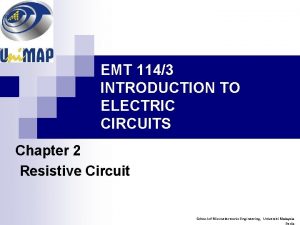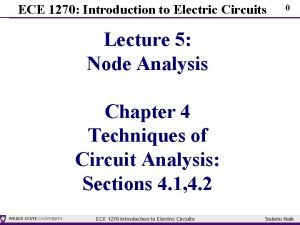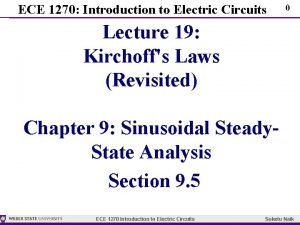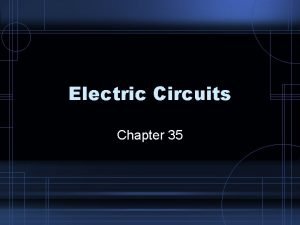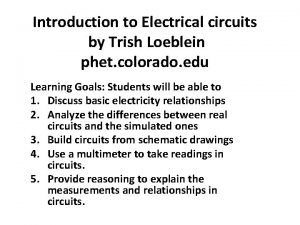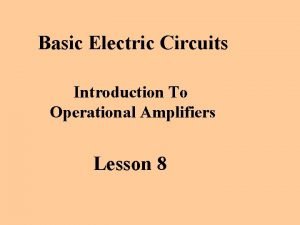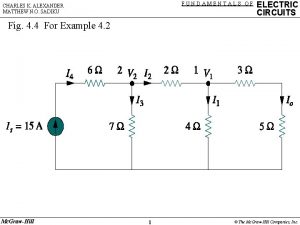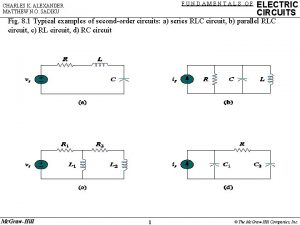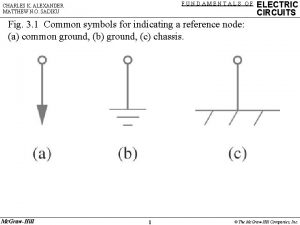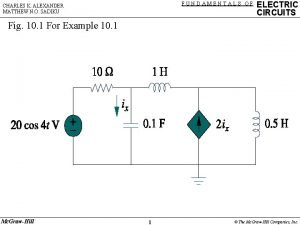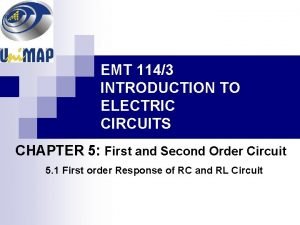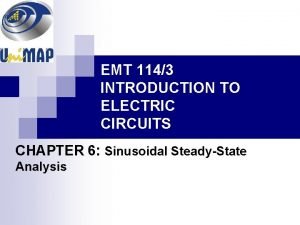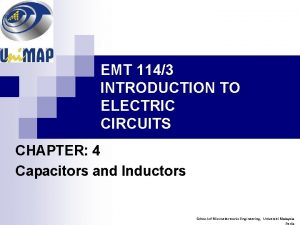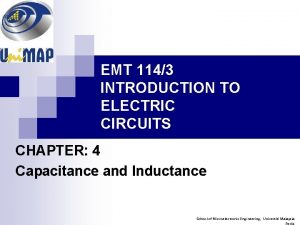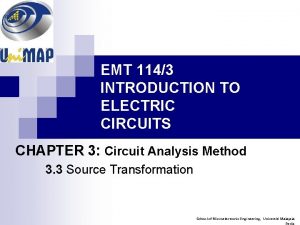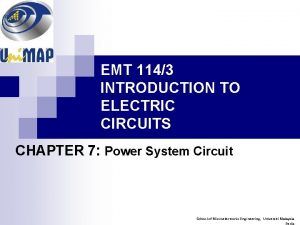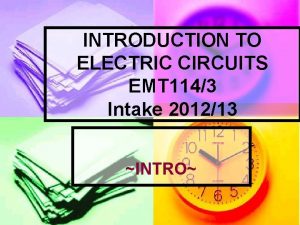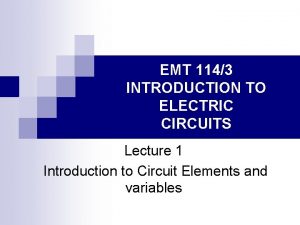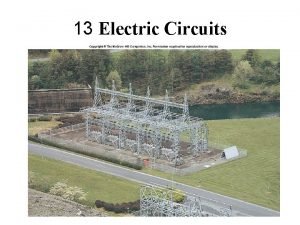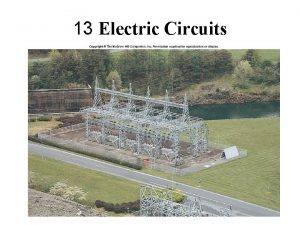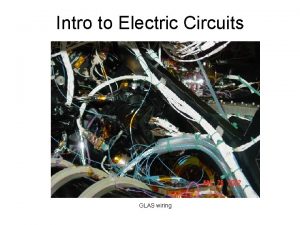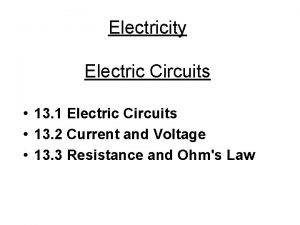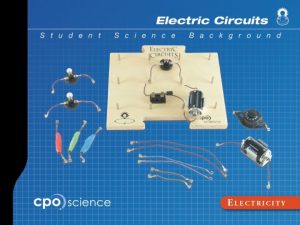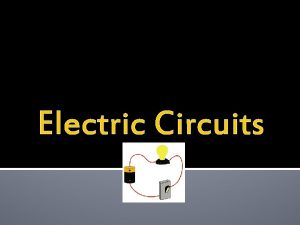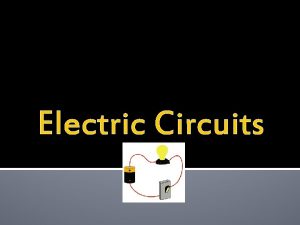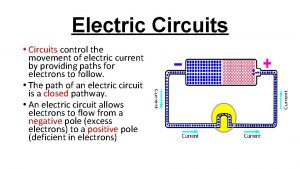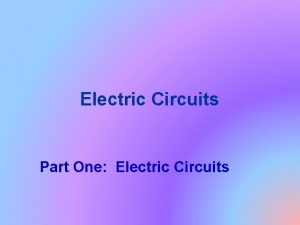EMT 1143 INTRODUCTION TO ELECTRIC CIRCUITS CHAPTER 3




























- Slides: 28

EMT 114/3 INTRODUCTION TO ELECTRIC CIRCUITS CHAPTER 3: Circuit Analysis Method 3. 1 Node-voltage Method School of Microelectronic Engineering, Universiti Malaysia

Chapter 3 Outline q Node Voltage q Mesh Current q Source Transformation ØThevenin ØNorton ØPower School of Microelectronic Engineering, Universiti Malaysia

CIRCUITS ANALYSIS METHOD q Node Voltage q Mesh Current q Source Transformation ØThevenin ØNorton ØPower School of Microelectronic Engineering, Universiti Malaysia

RECALL • Kirchhoff’s Current Laws (KCL) • Kirchhoff’s Voltage Laws (KVL) • Ohm’s Law School of Microelectronic Engineering, Universiti Malaysia

KIRCHHOFF’S CURRENT LAW (KCL) Sum of currents entering a node is zero Convention: +i is entering, -i is leaving Or The summation of currents entering a node is equal to the summation of currents leaving the node Convention: +i is entering and leaving School of Microelectronic Engineering, Universiti Malaysia

Nodal Analysis n Nodal analysis provides a general procedure for analyzing circuits using node voltages as the circuits variables. n Choosing node voltages instead of element voltages as circuit variables is convenient and reduces the number of equations. School of Microelectronic Engineering, Universiti Malaysia

Nodal Analysis Step to determine the node voltages: 1. Choose a node as the reference node. 2. Select voltages v 1, v 2, …, vn-1 to the remaining n-1 nodes. The voltages are referenced with respect to the reference node. 3. Apply KCL to each of the n-1 non-reference nodes. Use Ohm’s law to express the branch currents in terms of node voltages. 4. Solve the resulting simultaneous equations to obtain the unknown node voltages. School of Microelectronic Engineering, Universiti Malaysia

Cont. . Symbol for reference node a) common ground (b) ground (c) chassis ground School of Microelectronic Engineering, Universiti Malaysia

3. 1 Motivation on Nodal Analysis If you are given the following circuit, how can we determine (1) the voltage across each resistor, (2) current through each resistor. (3) power generated by each current source, etc. What are things which we need to know in order to determine the answers?

Example 1: Circuit with independent Current Source 3 In the diagram, node 3 is define as reference node and node 1 and 2 as node voltage labeled as; V 1 and V 2 Calculate the node voltages for above circuits. School of Microelectronic Engineering, Universiti Malaysia

At node 2, apply KCL eq : 2 At node 1, apply KCL Modify eq: 1 to eq: 2; eq : 1 School of Microelectronic Engineering, Universiti Malaysia

Example 2 3 1. How many nonreference node? 2. How many reference node? 3. Define node voltages School of Microelectronic Engineering, Universiti Malaysia


Nodal analysis with voltage dependant source If the circuit contains dependent sources, the nodevoltage equations must be supplemented with the constraint equation imposed by the presence of the dependent sources. School of Microelectronic Engineering, Universiti Malaysia

Example 3: Using nodal analysis, find V 0 in the circuit

3 i 1 v 1 i 3 5 i 2 + V 0 3 V 2 + – + 4 V 0 – – 1 i 1 + i 2 + i 3 = 0 Using Voltage divider so that v 1 + 5 v 1 - 15 + v 1 - or v 1 = 15 x 5/(27) = 2. 778 V, therefore vo = 2 v 1/5 = 1. 1111 V

Node analysis with SUPERNODE Case 1: Ø If voltage source is connected between reference node and a nonreference node, we set the voltage at the nonreference node equal to the voltage of the voltage source. Case 2: Ø If voltage source is connected between two nonreference node, the two nonreference nodes form a generalized node or SUPERNODE ; we apply both KCL and KVL to determine the node voltages

Example 4 CASE 1



Example 5 CASE 2 By applying the KCL and KCV, calculate the V 1 and V 2

a) Applying KCL to the supernode Eq: 1

b) Applying KVL to the supernode Eq: 2 Modify eq: 2 into eq: 1;

Example 6


Exercise 1 Find V 1 and V 2?

Exercise 2 With voltage dependent source, find V 1 and V 2?

To be continued….
 Introduction to electric circuits
Introduction to electric circuits Introduction to electric circuits
Introduction to electric circuits Ece
Ece Fundamentals of electric circuits chapter 4 solutions
Fundamentals of electric circuits chapter 4 solutions Electric current
Electric current Conceptual physics chapter 35 electric circuits
Conceptual physics chapter 35 electric circuits Chapter 20 electric circuits
Chapter 20 electric circuits 9
9 Fundamentals of electric circuits chapter 7 solutions
Fundamentals of electric circuits chapter 7 solutions Chapter 35 electric circuits answers
Chapter 35 electric circuits answers Types of circuits and ohm's law worksheet answers
Types of circuits and ohm's law worksheet answers Chapter 35 electric circuits
Chapter 35 electric circuits Advantages of parallel circuits over series circuit
Advantages of parallel circuits over series circuit Chapter 21 electric charge and electric field
Chapter 21 electric charge and electric field Chapter 21 electric charge and electric field
Chapter 21 electric charge and electric field Coulombs units
Coulombs units Chapter 21 electric charge and electric field
Chapter 21 electric charge and electric field Phet electric circuit
Phet electric circuit Electric circuits equations
Electric circuits equations Electric circuits nilsson
Electric circuits nilsson Principles of electric circuits
Principles of electric circuits Three elements of a basic program for electrical safety are
Three elements of a basic program for electrical safety are Fundamentals of electric circuits
Fundamentals of electric circuits Fundamentals of electric circuits
Fundamentals of electric circuits Superposition electric circuits
Superposition electric circuits Electric circuits grade 6
Electric circuits grade 6 Fundamentals of electric circuits
Fundamentals of electric circuits Fundamentals of electric circuits
Fundamentals of electric circuits Principles of electric circuits 10th edition answer key
Principles of electric circuits 10th edition answer key
